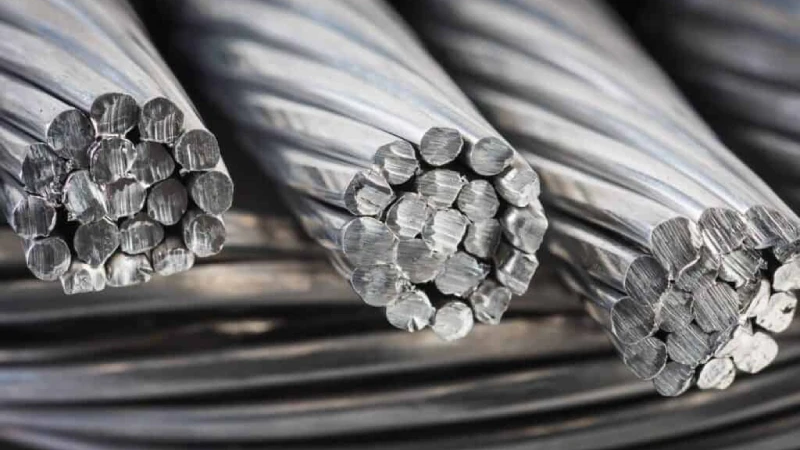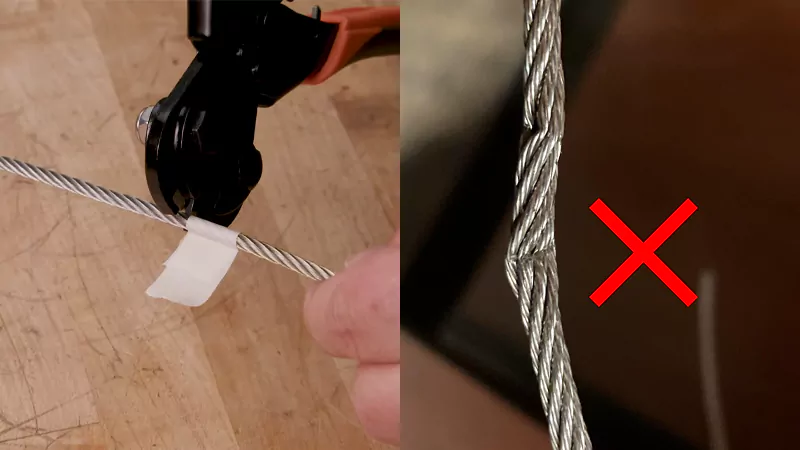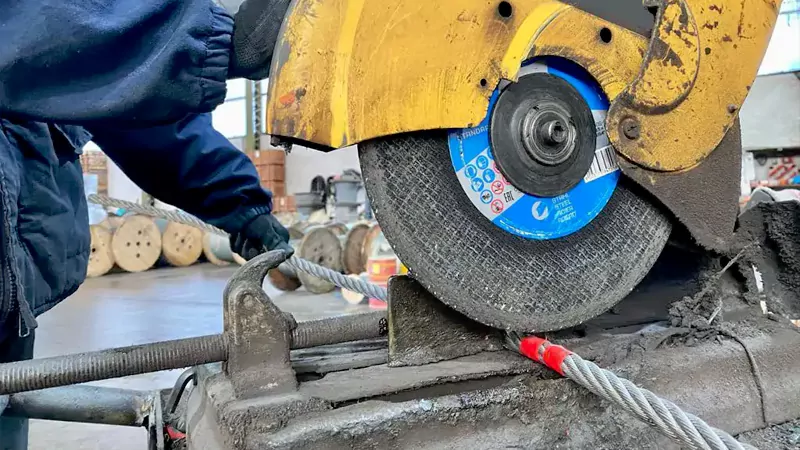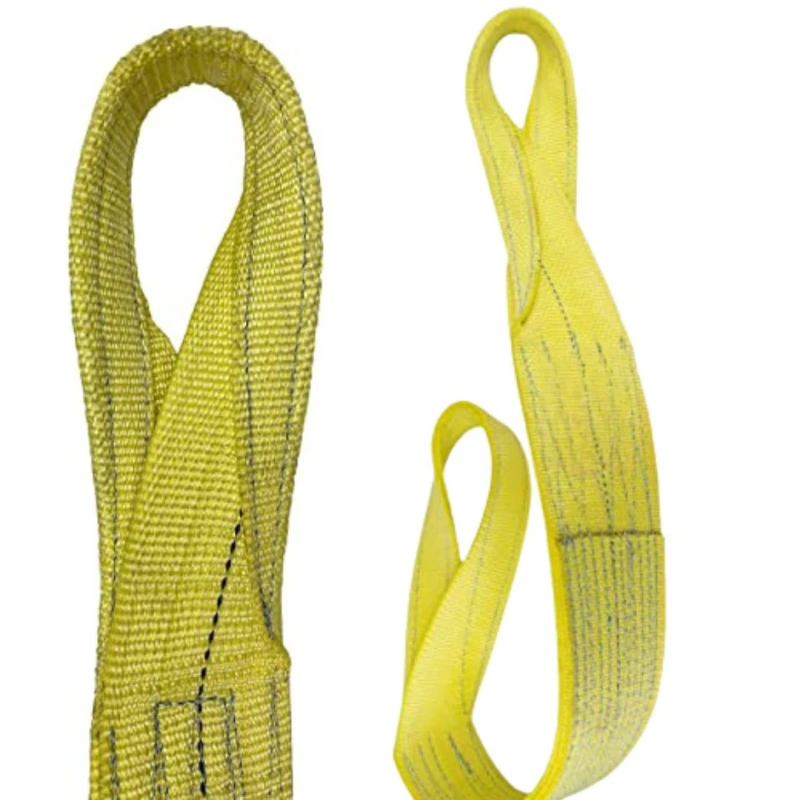You’ve measured perfectly, you have your mark, but the moment you cut that steel wire rope, it explodes into a useless, frayed mess. It’s a frustratingly common problem that not only wastes material but makes it nearly impossible to attach essential fittings and terminals. But what if you could get a clean, professional cut, every single time?
This is your ultimate guide on how to cut wire rope the right way. We’ll show you the industry-secret technique for how to cut wire rope without fraying, ensuring a perfect finish for any project. Whether you’re working with thin aircraft cable or heavy-duty winch lines, forget the frustration. Here, you will learn the correct methods and the best tools to turn a difficult task into a simple one.
Why a Clean Cut Is Non-Negotiable

Before we dive into the “how,” let’s establish the “why.” A clean cut on a wire rope is far more than a matter of neatness; it’s fundamental to the safety, functionality, and longevity of your entire project. Settling for a messy, frayed end can lead to significant problems down the line. Here’s exactly why a perfect cut is so critical:
- Safety First: A frayed end is essentially a bundle of sharp, unpredictable needles. These wires can easily cause deep, painful lacerations or leave metal splinters in your hands, turning a simple task into a trip for first aid. A clean cut is a safe cut, eliminating this serious risk of injury.
- Proper Functionality: Simply put, a crushed or frayed end won’t fit. Most hardware—like swage fittings, sleeves, clips, and terminals—is manufactured with precise tolerances. An end that isn’t clean and compact will be impossible to insert correctly, rendering that expensive length of rope completely useless.
- Long-Term Integrity: The cut is the rope’s first line of defense against unraveling. When all strands are cut evenly, the rope’s complex structure remains intact under load and vibration. A poor cut introduces a weak point, which can lead to premature wear and potential failure.
- Professional Results: The quality of your cut is a direct reflection of your workmanship. A crisp, smooth end not only looks professional but also demonstrates a commitment to detail and reliability. It’s the clear difference between a durable, finished assembly and one that looks amateurish and untrustworthy.
Essential Tools & Materials for the Perfect Cut
Having the right tool for the job is 90% of the battle, and this is especially true when cutting steel wire rope. Using the wrong tool is the single biggest reason people end up with a frayed, unusable mess. Here is a detailed breakdown of what you should use, what you can use, and what you should absolutely avoid.
The Gold Standard: Dedicated Wire Rope Cutters
These tools are purpose-built for one job: to cut wire rope cleanly. Their defining feature is a set of curved jaws that encircle the rope, applying even pressure from all sides to slice through every strand simultaneously. This action prevents the rope from flattening and fraying.
- Manual Wire Rope Cutters: For most common sizes (typically up to 1/4″ or 6mm), a high-quality pair of manual cutters is perfect. They operate like scissors, with long handles providing the leverage needed for a clean, one-shot cut. They are the go-to tool for DIY projects like deck railings and home gyms.
- Ratcheting Cable Cutters: When you step up to thicker or tougher ropes (around 3/8″ or 10mm), a ratcheting cutter offers a significant mechanical advantage. Each squeeze of the handle tightens the blades incrementally, allowing you to cut through thick cable with much less physical effort.
- Hydraulic Cutters: For the thickest and strongest steel wire rope, hydraulic cutters are the professional choice. They use hydraulic pressure to exert immense force, shearing through rope over 1/2″ (12mm) and larger with surprising ease, leaving a perfectly clean, round profile.
A Viable Alternative: The Angle Grinder
For many, an angle grinder is a tool they already own, and it can be very effective for cutting wire rope, especially thicker gauges.
The key is to use the correct accessory: a thin metal cut-off wheel. Do not use a thick grinding disc, as it will generate too much heat and chew through the rope rather than cutting it cleanly. While a grinder is fast and powerful, be aware of the downsides: it creates a storm of sparks, is very loud, and the heat can slightly affect the temper of the wire ends. Proper preparation (wrapping the rope) is absolutely essential when using this method.
Tools to Avoid: The Crushers and the Tearers

- Bolt Cutters: This is the #1 tool to avoid. A bolt cutter does not cut; it crushes and pinches. Its jaws are designed to apply immense pressure to a single point to break a solid bar. When used on wire rope, it flattens the profile, mangles the strands, and guarantees a frayed, unusable end.
- Hacksaw: While it might seem logical, a hacksaw is a poor choice. The back-and-forth sawing motion catches and pulls individual wires, tugging them out of the weave. Even with a tightly wrapped cut-point, you will almost certainly end up with a frayed, messy result after a lot of effort.
- Pliers/Side Cutters: For anything other than the absolute thinnest wire rope (1/16″ or less), standard pliers or side cutters lack the force and blade design to do anything but mangle the rope and damage your tool.
Your Anti-Fraying Toolkit: Essential Preparation Materials
These materials are just as important as the cutting tool itself. Using them is the secret to a clean cut.
- Tight-Sticking Tape: High-quality electrical tape or vinyl tape is the most common and effective choice. It should be wrapped tightly around the rope on both sides of your cut mark to bind the strands together during the cutting process.
- Zip Ties: A good alternative to tape. You can use pliers to pull them extremely tight for a secure hold.
- Seizing Wire: This is the traditional, professional method. It involves tightly wrapping a thin, malleable wire around the rope. It provides the most secure hold, especially on large-diameter ropes.
Don’t Forget: Essential Safety Gear
- Safety Glasses: This is non-negotiable. Metal fragments can be ejected during a cut, especially when using an angle grinder.
- Heavy-Duty Gloves: Protect your hands from the inevitable sharp edges of the rope and provide a much better grip on your tools.
The Golden Method: How to Cut Wire Rope Without Fraying Step-by-Step
You can have the best tool in the world, but if you skip the preparation, you’ll still get a mediocre result. This proven, four-step method ensures a perfect, clean cut every time, regardless of whether you’re using dedicated cutters or an angle grinder. The secret to success is all in the prep work. Follow these steps precisely for a professional finish.
Step 1: Measure Twice, Mark Once
Accuracy starts here. Using a quality tape measure, determine the exact length you need. Once you have your measurement, use a fine-tipped permanent marker to make a single, clear, and highly visible line on the wire rope. This will be your cutting guide. A clear mark prevents hesitation during the cut, which is crucial for a clean outcome.
Step 2: Wrap and Secure (The Anti-Fraying Secret)
This is the single most important step to guarantee a fray-free cut. Before you even think about cutting, you must bind the rope’s strands together.
Take your electrical or vinyl tape and begin wrapping the rope about a half-inch (or 1 cm) to one side of your mark. Keep the tape under constant, high tension as you wrap towards the mark. The width of your wrapped section should be at least equal to the rope’s diameter (e.g., for 3/8″ rope, wrap at least a 3/8″ wide band). Now, repeat this process on the other side of the mark. When you’re done, your mark should be in the center of two tightly-wound bands of tape. This compression holds all the strands and the core securely in place, preventing them from springing apart when the cut is made.
Step 3: Execute the Cut
With the rope properly secured, it’s time to make the cut.
- Using Dedicated Cutters: Position the cutting jaws directly over your mark. The goal is to cut the rope in one firm, confident, and fluid motion. Don’t try to “nibble” at the rope with small cuts. A single, decisive action will produce the cleanest result.
- Using an Angle Grinder: Secure the rope firmly in a vise or with clamps to prevent it from moving. After putting on your safety glasses and gloves, bring the spinning cut-off wheel down onto your mark in a swift, smooth motion. Let the speed of the tool do the work; don’t apply excessive force.
Step 4: Inspect and Finish
Once the cut is complete, you can remove the small piece of tape left on the very end of the rope. The end might be slightly sharp or have a small metal burr. For a perfect finish, you can lightly tap the end with a hammer on a flat metal surface to round it off, or give it a quick, gentle touch with a metal file to smooth any sharp edges. This final touch makes it safer to handle and easier to insert into hardware fittings.
Comparing the Methods: Grinder vs. Bolt Cutters vs. Specialized Cutters

Choosing the right tool is critical, as each one interacts with the wire rope in a fundamentally different way. Let’s directly compare the three most common options so you can understand the pros and cons of each.
Winner: Specialized Cutters (The Clean Cut)
These tools are the undisputed champions. Their scissor-like, encircling jaws are engineered to slice cleanly through all strands at once. This results in a round, un-crushed end that is immediately ready for fittings. They are fast, precise, and by far the safest option. While they represent an initial investment, the time saved and the quality of the finish make them worth every penny for anyone who works with wire rope regularly.
Contender: Angle Grinder (The Brute Force Cut)
So, can you cut wire rope with a grinder? Absolutely. An angle grinder equipped with a thin cut-off wheel is a powerful and effective method, especially for thick-gauge ropes where manual cutters might struggle. It blasts through the rope quickly. However, this power comes with trade-offs: it’s loud, throws a shower of sparks (a serious fire hazard), and the high heat can affect the temper of the wire ends. It is a viable option, but it requires more stringent safety precautions—including gloves, full eye protection, and a clear workspace—and still depends on a tight tape wrap to prevent fraying.
Avoid at all Costs: Bolt Cutters (The Crushing Failure)
And what about bolt cutters? Can they cut wire rope? The short answer is no. This is the most common mistake people make. Bolt cutters are designed with blunt, opposing jaws that apply immense crushing force to snap solid metal like bolts and rebar. When used on wire rope, they don’t cut; they mangle. They flatten the rope’s profile, severely damaging the strands and causing an explosive fray that is impossible to repair. Using bolt cutters will ruin your rope, frustrate you, and produce an end that is completely unusable for any type of fitting.
Handling Different Rope Types and Sizes
The “Golden Method” of cutting—prepare, wrap, and cut—is a universal principle that applies to virtually all common types and sizes of wire rope.
How to cut galvanized wire rope? The process is identical to cutting standard steel rope. The zinc coating on galvanized rope provides corrosion resistance, and making a clean, crisp cut helps to keep this protective layer as intact as possible right up to the end, preventing premature rusting.
For other types like stainless steel or for the broader category of how to cut metal wire rope, the same rules apply. The main factor that changes with different sizes is your tool choice. While a small manual cutter is perfect for 1/8″ rope, you must scale up to a hydraulic cutter or an angle grinder to get a clean cut on thick 3/8″ rope. The preparation, however, remains the same.
Conclusion
Cutting steel wire rope doesn’t have to be a frustrating task that ends in a frayed mess. As we’ve shown, the secret to a perfect, professional finish lies in two simple principles: meticulous preparation and choosing the right tool for the job. Always remember that tightly wrapping your cut mark is the single most effective technique to prevent the strands from unraveling. It is the critical step that separates amateurs from professionals.
By pairing this crucial prep work with a dedicated wire rope cutter or an angle grinder—and staying far away from destructive bolt cutters—you will guarantee a clean, usable end every single time. You now have the knowledge to tackle your next project with confidence and achieve results that are safe, functional, and look great.
FAQs
How to cut 3/8 wire rope?
Due to its thickness, the best tools are a hydraulic wire rope cutter or an angle grinder with a cut-off wheel. Always wrap the rope tightly before cutting.
How to cut 3/16 wire rope?
A good quality pair of manual ratcheting or long-handled wire rope cutters is ideal. An angle grinder also works well.
How to cut 1/8 wire rope & 1/16 wire rope?
For these common smaller sizes, a standard manual wire rope cutter provides a perfectly clean cut. The preparation step of wrapping with tape is still highly recommended.
Can you use a grinder to cut wire rope?
Yes, a grinder with a cutoff wheel is a very effective method, especially for thicker ropes. Ensure the rope is secured and you wear proper safety gear.
Can I use bolt cutters on wire rope?
No, you should avoid using bolt cutters. They will crush the rope and cause the strands to fray badly, making the end unusable for most applications.


